THE MODRÝ KAMEŇ CASTLE | ||
The Modrý Kameň (Blue Stone) Castle stands on a cliff at the foot of the Calvary Hill (Kalvársky vrch) that marks the beginning of the Plain of Krupina (Krupinská planina). According to the oral tradition, it was named by the color of the building stone or the cliff on which it was built. It is a rare monument – the ruins of the Upper Castle are structurally connected with the manor house in the adjacent fort on a rocky outcrop about 350 m above sea level. The origin of the castle dates back the period before 1285, the year when it was mentioned in documents for the first time. However, the local memorial plaque mentions the origin of the castle before the invasion of the Tatars (1241). According to the mention from 1285, the owner and supposed builder of the castle was Peter Forró, a direct ancestor of the Balaša family. At the turn of the 13th and 14th centuries, it was shortly occupied by Matthew Čák of Trenčín. The Balassas regained it only after his death in 1321. The archaeological research in 2013 – 2020 indicated that in the 14th and 15th centuries, the castle complex was several times rebuilt and expanded. At that time, the Balassas were one of the most important and richest families in the Kingdom of Hungary, and held important political positions granted by the rulers. After the Battle of Mohács in 1526, when the Hungarian troops suffered a crushing defeat, the Turks began to threaten the territory of Novohrad. The strategic location of the Modrý Kameň Castle resulted in its growing importance in the defense of mining towns. Therefore, in 1530, they strengthened its fortification system. In 1559, the parliament decided to repair the castle with state money. At that time, the castle was owned by Ján Balassa (1518 – 1577), who was, in 1562, appointed by King Ferdinand of Habsburg a Commander of the Troops of the mining area and Head of Zvolen County. He was the father of the renowned European poet and playwright, the hero of the anti-Ottomans struggles Valentín I Balassa (1554 – 1594). The Ottomans tried several times to conquer the Modrý Kameň Castle. They succeeded on July 15, 1575, after a three-day siege. | ||
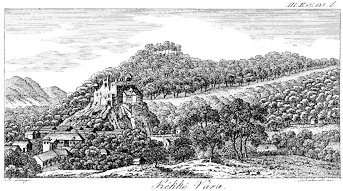 | 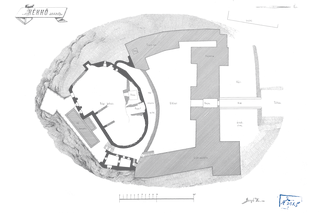 | 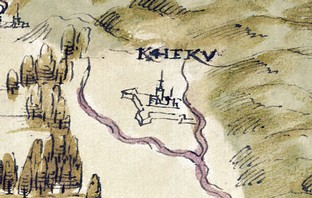 |
The castle on an engraving by Samuel Lenhard and Rudolf Lányi from the first half of the 19th century | Floor plan of the castle by Karol Bergh from 1866 | Illustration of the Blue Stone Castle on the map of the mining area by Nicola Angielini from 1573 – 1575 |
After the defeat of the Turks at Fiľakovo Castle (1541) – the seat of Fiľakovo Sanjak, which also included Modrý Kameň (Blue Stone) Castle, the imperial troops also occupied the Balassi Castles – Modrý Kameň and Divín. This happened at Modrý Kameň on 15 December 1593. The fleeing Turks badly damaged the castle and even blew it up. The destroyed castle fell into disrepair until the end of the war, when the emperor returned it to the Balaša family. Zsigmond Balaša (1572 – 1623) in 1609 – 1612 took care of its complete renaissance reconstruction. The Turks invaded and occupied Modrý Kameň Castle even in 1659. The next owner of the castle was Valentin II Balassa (1624 – 1684). In 1658, he obtained the right for the town of Modrý Kameň to hold fairs on specified days of the year granted by Emperor Leopold I. The original historical imperial document from October 6, 1658 is stored in the State Archives in Veľký Krtíš. The craft trade flourished and the population of the village around the castle grew. At the time of the Rákoci uprisings (1703 – 1711), Modrý Kameň Castle became a refuge for the Novohrad nobility. After the devastation of aristocratic residences in Novohrad, when the Kurutz army conquered the Castle of Halíč, Modrý Kameň Castle had also surrendered, and its owners joined the anti-Habsburg camp. After the conclusion of the Peace Treaty of Szatmár in 1712, which definitively ended the wave of anti-Habsburg uprisings, Martin Kókai, a Colonel in Rákoci´s army, returned to Modrý Kameň Castle, where he spent some time with a group of Kurutz soldiers, and in a moment of madness he set the castle on fire. Most of the castle was destroyed by fire. The oldest, vastly damaged part of the castle remained in ruins. In 1730, the son of Gabriel Balassa (1642 – 1700) Pavol II Balassa (1699 – 1770) and his mother Mária Perényi had a three-winged Baroque mansion built on the remains of the fortifications in the forecourt. The ruins of the Upper Castle were gradually turned into a castle garden. | ||
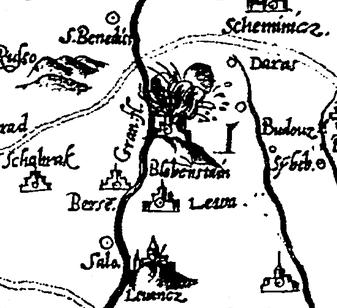 | 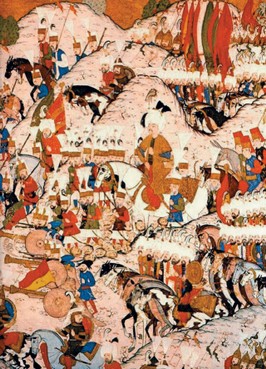 | 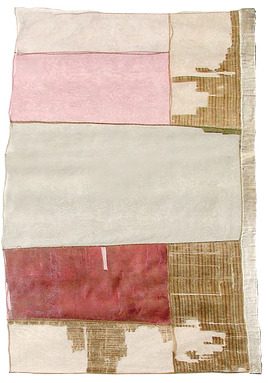 |
Map of the chronology of the fights between Christians and Ottomans in the Kingdom of Hungary in 1593 – 1598 (Augsburg 1598) illustrating the destruction of the Modrý Kameň Castle | Contemporary Ottoman depiction of the Battle of Mohács (1526) | Torso of the ceremonial Ottoman flag. Place of discovery: the surroundings of Modrý Kameň |
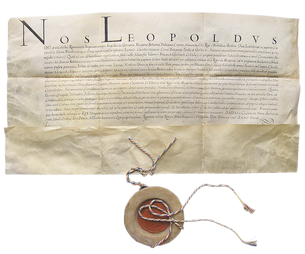 |  | 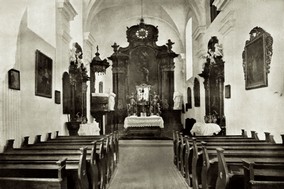 |
The Imperial Charter of Leopold I, granting the town of Modrý Kameň the right to fairs (1658) | Romatic garden on the ruin of the gothic-renesance castle (1907) | St. Anne´s Chapel (1759) with the original furnishings (1907) |
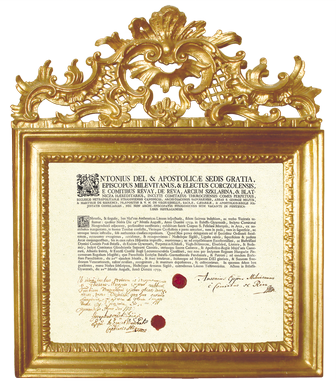 | 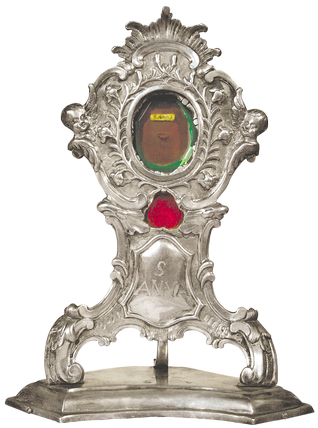 | 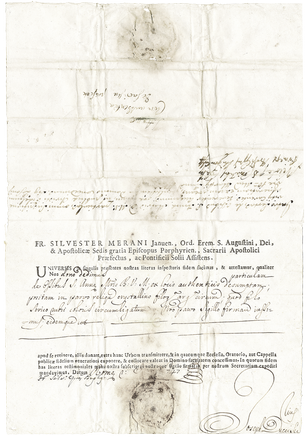 |
Verification of the relic of St. Felician | The reliquary of St. Anna | Verification document of the reliquary of St. Anna |
In 1759, Pavol II Balassa, the “Apostolic Count”, had the last extension of the manor house built - the St. Anne´s Chapel, the saint whom the Balaša family worshiped as their patron saint. The title of the Apostolic Count was granted to him by Pope Benedict XIV for his active participation in the re-Catholization efforts of the Habsburgs trying to regain the reformed believers back into the Catholic Church. Probably at this time he also established Calvary, a pilgrimage site near the castle. The next generations of the Balašas also contributed to the development of the settlement around the castle. The aristocratic Balaša family owned the Modrý Kameň Castle for almost 600 years. In the middle of the 19th century, the Forgáč family became the owners of the castle estate. Their modifications to the estate included a fountain, an English park, the park of St. Anne with a tennis court and a shooting range. In the nearby forests, they established a menagerie with the breeding of cloven-hoofed game. In 1890, count Tibor Károlyi bought the Manor for his daughter Gabriela Almássy. After the establishment of the Czechoslovak Republic, in 1924 she sold all her property including the adjacent land to the Czechoslovak state. The original furnishings of the manor were not preserved. In 1923, the town of Modrý Kameň became a district town. The Manor premises housed the district administration offices – the district office, the district court, the labor office, the school inspectorate and various other institutions. In 1927 – 1928, the premises of the former stables next to the premises of the district court were converted into prison cells. Since 1960, the manor was used as a warehouse for the state-owned pharmaceutical company Medika. From 1968, it housed the State District Archive. In 1991, the castle became the Museum of National Geography. The museum launched its professional activities and administration under very difficult conditions in the devastated premises of the landmark and almost without any collections. In 1994, the founder of the museum - the Ministry of Culture of the Slovak Republic, decided that the Museum would specialize its collections and activities on puppetry and toys. Since 2002, it has functioned as a specialized organizational unit of the Slovak National Museum - The Museum of Puppet Cultures and Toys the Modrý Kameň Castle. | ||
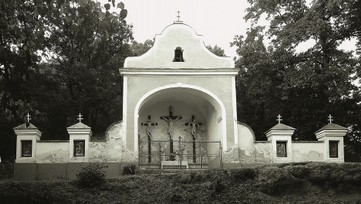 | 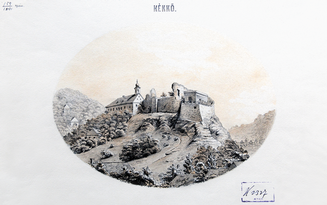 | 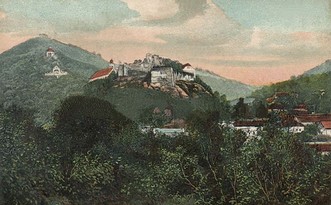 |
The establishment of the Modrý Kameň Calvary in the mid-18th century attributed to Pavol Balassa | Illustration of the castle by Karol Bergh from 1866 | The castle on a colored postcard from the late 19th century |
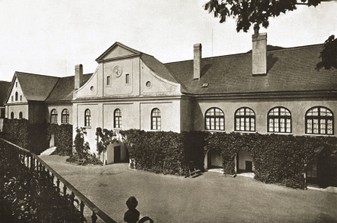 | 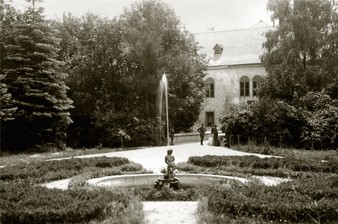 | 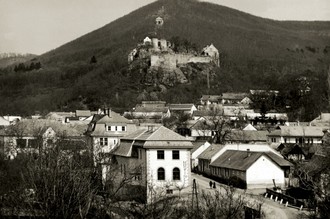 |
Courtyard of the castle (1907) | View of the English park in front of the manor house | View of the castle and the town in a photograph from the 1920s |
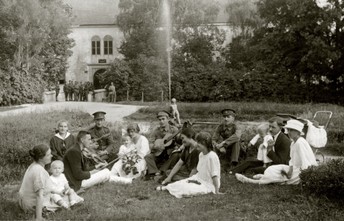 | 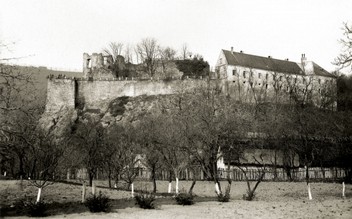 | 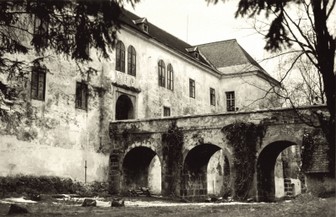 |
View of the company of the Czechoslovak military garrison in an English park in front of the manor house | View of the castle from the east in the 1920s | Northern view of the castle in the 1920s |
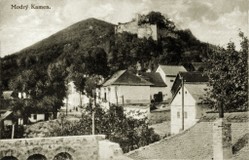 | 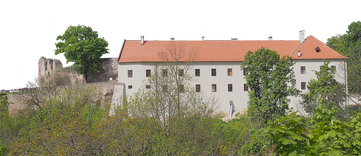 | |
View of the castle | In 2016, the East Wing of the manor house was reconstructed within the framework of the Norwegian Grant Project HraMoKa | Aerial view of Modrý Kameň Castle today |
FERENCOVÁ H., ANTOLOVÁ E. (zost.). Rod Balašovcov v 13. až 19. storočí: Zborník z medzinárodnej konferencie Modrý Kameň, Slovenské národné múzeum – Múzeum bábkarských kultúr a hračiek hrad Modrý Kameň 2013. Ferencová H., Antolová E. (zost.). Valentín Balaša a jeho doba – historické súvislosti : Zborník z II. medzinárodnej konferencie Modrý Kameň, Hradčan Modrý Kameň, 2016 FERENCOVÁ, H., 2018: Uhorský rod Balašovcov na hrade Modrý Kameň, Hradčan Modrý Kameň, 2018 BELJAK J., FERENCOVÁ H., HAĽAMA M., JANURA T., KALIČIAKOVÁ Z., MALINIAK P., ŠIMKOVIC M.: Výskum A obnova Hradu Modrý Kameň 2013 – 2019, Hradčan Modrý Kameň, 2020 | ||
Go to content
Back to content


